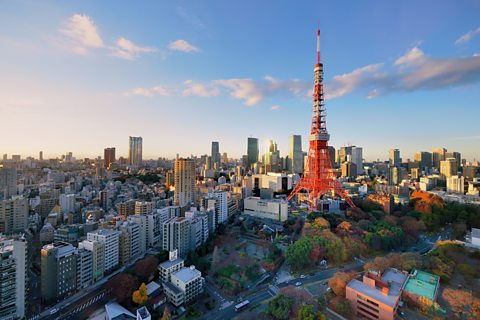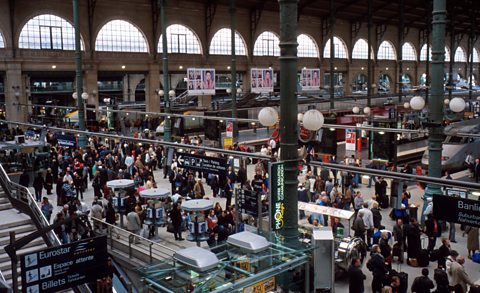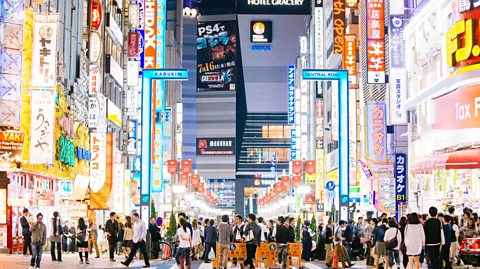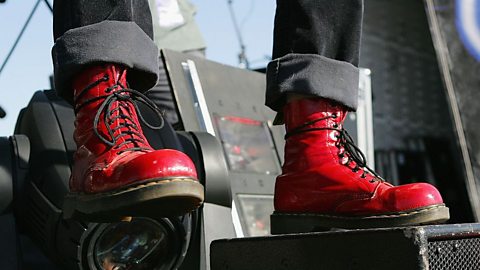The eyes of the sporting world have been on Tokyo in 2021.
But attention will turn to Paris for the Olympics and Paralympics in three years' time.
We've already seen a preview of the French capital's plans at the closing ceremony of the Olympic Games, with the final action in Japan at the Paralympics also set to feature a nod to the 2024 hosts.
But while thereãs just over 6,000 miles between Tokyo and Paris, there are plenty of similarities between the two capital cities. ôÕÑ¿èÓ Bitesize explores the things Tokyo and Paris have in common.
Iconic towers
When you think of Paris, undoubtedly, the Eiffel Tower comes to mind.
But as you may have seen across the coverage of the sporting action this summer, Tokyo has its own tower to match.

In fact, the Japanese version of the tower is slightly taller. Opened in December 1958, the Tokyo Tower is 332.9m tall (1,092ft) and is painted white and ãinternational orangeã to comply with air safety regulations.
For comparison, the Eiffel Tower opened in March 1889 and is 324m tall (1,063ft). Both towers are essential tools for broadcasting in the respective capitals, with the upper reaches of the structures housing antennas for television and radio signals.
Faster than a speeding bullet (train)
Unsurprisingly, for such highly populated cities, both Tokyo and Paris are well served by train networks.
Tokyoãs subway system has 285 stations across 13 lines while the Paris Mûˋtro has 304 stations on its 16 lines.

Both cities are also home to high-speed rail networks with the TGV and Shinkasen whisking passengers across France and Japan respectively.
But itãs the sheer volume of people using trains in each city that really stands out.
Tokyo is home to the busiest railway station in the world, with more than 3.5 million people using the cityãs Shinjuku Station every day.
Seven of the worldãs top ten busiest stations can be found in the Japanese capital, showing just how popular train transport is in the country.
But Parisians travel by train fairly frequently as well. Gare du Nord is the worldãs busiest train station outside Japan, with around 700,000 daily passengers.
Light fever
Every night, the Eiffel Tower is lit up by 20,000 bulbs, illuminating the famous landmark all across the Parisian skyline.
But that lightshow is not the reason the capital is known as the City of Light.
That nickname dates back to the mid-17th Century. After a period of unrest throughout France, King Louis XIV was determined to restore law and order. His new Lieutenant General of Police, Gabriel Nicolas de la Reynie, was instructed to increase the number of police in the city, but also chose to install more street lighting to deter criminals - which gave birth to the famous nickname.
While illuminating a city with oil lamps, lanterns and candles might seem somewhat old fashioned, Tokyo has a similar light appeal, albeit much more futuristic.

Tokyo is thought to have the most neon signs of any city in the world ã with the Shinjuku special ward in the city famous for its shimmering bright colours.
House of mouse
The rides, shows and parades of Disneyãs theme parks might initially make you think of sunny days in Florida or California.
But Mickey and Minnie Mouse can also be found in Paris and Tokyo.
Tokyo Disneyland opened in 1983, the first Disney theme park outside of the United States. Located in Urayasu, to the south-east of central Tokyo, the resort averages more than 17 million visitors each year. A second park ã Tokyo DisneySea ã opened in 2001.
Disneyland Paris opened as Euro Disney in 1992 and now averages around 15 million visitors annually. The theme park is based in Marne-la-Vallûˋe to the east of the city. Like Tokyo, Disneyland Paris opened a second park ã Walt Disney Studio Park ã in 2002.
Dedicated followers of fashion
Think Paris, and you might think of high fashion, designer labels and immaculately dressed people.
Once again, King Louis XIV is credited with beginning the fashion legacy. He was fond of the finer things and believed that luxurious fashion could help to establish Franceãs cultural authority overseas. The king insisted those attending his court in Versailles were dressed in suitably grand style.
In the 18th Century, Paris had become established as a fashion capital and the rich would come to the city purely to get the latest trends.
Paris may have been at the forefront, but in more modern times, Tokyo is one of the top destinations in the world for fashion lovers.
The cityãs Harajuku district gave birth to a street-style of fashion, with bright, bold and cartoonish styles of clothing.
A popular area to this day with Tokyo teenagers, Harajuku is the heart of the kawaii culture ã all things cute ã even if slightly more mainstream retailers have now set up shop there.

Six of the worldãs most amazing railway journeys
From the highest railway to one of the longest, these aren't any ordinary train journeys.

Tokyo 2020: Learn basic Japanese phrases for the Olympics and Paralympics
Teacher Sayaka can help you support Team GB and ParalympicsGB at the Games with some key phrases

Histories of the mini skirt, the white wedding dress, and why the tale you've probably heard about nylon isn't true.
